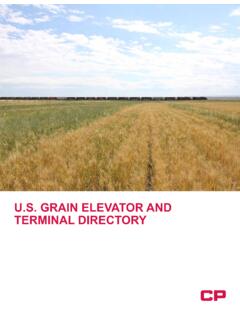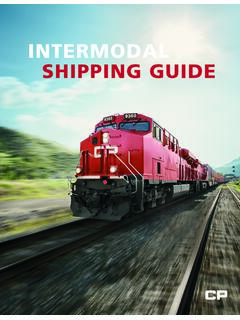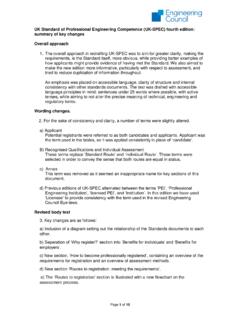Transcription of Engineering Guidelines for Private Siding Design and ...
1 1 Engineering Guidelines for Private Siding Design and Construction Revised June 2017 2 Guidelines for Private Siding Design and Construction Table of Contents ..2 Building Private Track and Facilities ..3 Design Standards ..6 Drawing Standards .. 10 Material Standards .. 13 Construction .. 17 Flagging ..19 Appendices Minimum Safety Requirements for Contractors Working on Railway Property Industrial Track Drawings 3 Foreword The initial contact for industries requiring a Private Siding is the Canadian Pacific (CP) Industrial Development group. Industrial Development leads a Private Siding project from concept to completion and is the main point of contact for the customer. The CP Engineering department is responsible to approve the Engineering Design for a Private Siding .
2 CP may also build a portion of the Private Siding as required and in accordance with a construction agreement. The CP generally follows the "Manual of Recommended Practice" of the American Railway Engineering Association (AREMA) unless otherwise specified. All materials for the track work shall comply with applicable specifications and standards of AREMA and CP. The purpose of this document is to layout the minimum requirements for a Private Siding Design which will allow CP to approve the plan. The document also provides general information about the construction process with CP. CP requires all contractors to adhere to our Minimum Safety Requirements for Contractor working on Railway Property policy which is included in the appendices. Highlighted within the policy is the need for flag protection if work (including survey, construction, etc.)
3 Is required on/around CP tracks. 4 Building Private Trackage and Facilities Development of detailed Design Once a conceptual review has been completed with Industrial Development, the customer arranges for an Engineering consultant to develop a detailed Design for their Private Siding . These drawings are to be signed by a Professional Engineer. Submission of detailed Design to CP The detailed Design drawings prepared by the industry s consultant are to be submitted to Industrial Development for review. The proposed Design will be evaluated against CP and AREMA Standards, some of which are outlined in this document. The drawings required for submission are outlined below. Plan submittals should be in PDF format with 11 x 17 sheet size. A CADD submission may be required depending on the size and complexity of the project.
4 Review ensures that the Design meets CP requirements and CP approval is required before moving to the construction stage. Construction Process Upon CP approval of the Design , Industrial Development will prepare a construction agreement for execution. Once the construction agreement is in place, CP will order materials and schedule CP construction forces to perform the work as detailed in the agreement. This usually involves installation of mainline turnouts, signals work, switch heaters, etc. The customer and its contractors will perform all work beyond the clearance point in accordance with the approved track Design and construction agreement. The customer will coordinate its construction work with CP. Customer will be responsible for locating all underground and above ground utilities, and, if required, relocating them or constructing protection around them.
5 Any deviation or changes from the approved plans that affects either the track work or the structures around the track work must be reviewed and approved by CP. There is to be no work within the CP ROW without prior authorization from CP. Completion and Operation Once construction is complete, an authorized CP employee will conduct a final inspection to ensure CP standards have been met. This must occur prior to commencing operations on the Private Siding . A signed Private Siding agreement is required prior to commencement of operations on the Private Siding . Industrial Development will prepare the agreement for signature. A plan of the Private Siding in accordance with example Siding agreement plan attached in the appendix section will form a part of the Private Siding agreement. 5 Design Standards Track Curvature Indicate Beginning of Curve (BC), End of Curve (EC) and spiral points on the track plan.
6 A curve data table must accompany the curve shown on a track alignment drawing. All curves and turnouts will be shown with their appropriate stationing. Stationing along the railroad tracks will be in feet or meters and be shown in the format of 00+ Minimum distance between reverse curves shall be 100 feet (30 meters). Curves must have 100 feet (30 m) of tangent between the Point of Curve (PC) and Point of Switch (PS), Bridge End or Road Crossing. All curves must end at least 60' short of building doors or other objects located where there is a minimum clearance of 8'6". Two (2) inches must be added to the clearance of 8'6" for each degree of curve if the curve ends closer than 60'. Curves that are greater than 7 degrees 30 minutes will use elastic fasteners and Grade 5 (7 x9 ) ties.
7 Maximum recommended curvature is 9 degrees 30 minutes. Curvature greater than 9 degrees 30 minutes will require special approval and may be considered only if conditions are such that there is no other viable alternative. These curves will be looked at on a case by case basis. For unit train loop tracks the maximum curvature shall be 7 degrees 30 minutes. Grades in industry service tracks shall not exceed unless it is a unit train facility in which case the maximum shall not exceed Minimum vertical curve length shall be 200 feet (60 m). The maximum practical grade is dependent on operating and other factors. Vertical curves shall not extend into limits of turnout switch ties. Turnouts All mainline turnouts will be furnished and installed by the railroad at industry expense.
8 The railroad will construct track up to the clearance point only. Additional costs for mainline turnout installation could include (but not limited to): fiber cable protection or relocation, signal modifications, power switches, electric locks, and switch heaters. Turnouts will be located in tangent track and a minimum 100 (30 m) of tangent track must be placed between reverse curves and the point of switch. Industry will be responsible for building a turnout construction pad for each new turnout as well as road access to each mainline turnout for CP forces to maintain turnout. Mainline turnouts shall be a minimum of # 11. Unit train and high volume facilities will be required to have a minimum of # 15. Turnouts on industry maintained track shall be minimum #9 with 115# rail, it is recommended that minimum #11 turnouts be utilized on industry track where Design permits.
9 6 Turnouts will show point of switch (PS), and the turnout number with direction. Include weight of rail and if it is to be new rail or relay rail. (ie. #.15 RH (Right Hand) 136lb New). Mainline turnouts may be required to have switch machines, switch heaters and be signalized depending on their location. Grounding Track(s) being used to unload/load flammable materials shall be properly grounded and bonded. Grading Construction of an adequate subgrade will be the responsibility of the customer. The customer should retain a professional engineer to Design the subgrade. The Contractor shall place and compact suitable materials in embankments and shall finish the embankments to the grade, slope and alignment as shown on the plans. Suitable materials shall consist of soils free from organics, debris, and frozen materials.
10 Embankment slopes shall be compacted and dressed to provide a uniform and dense slope. If unsuitable materials are encountered within the track roadbed areas that will affect stability of the roadbed, they shall be removed. Unsuitable material removed shall be replaced to grade with suitable material and properly compacted. The Contractor shall operate sufficient equipment to properly compact the embankment. Utilize construction procedures and drainage Design that will provide a stable roadbed. Each layer shall not exceed 6" (150 mm) in loose depth and shall be compacted to the dry density as specified before additional layers are placed. All embankments shall be compacted to a density of not less than 95% of the maximum standard laboratory density, and not more than +4 percentage points above the optimum moisture content.











